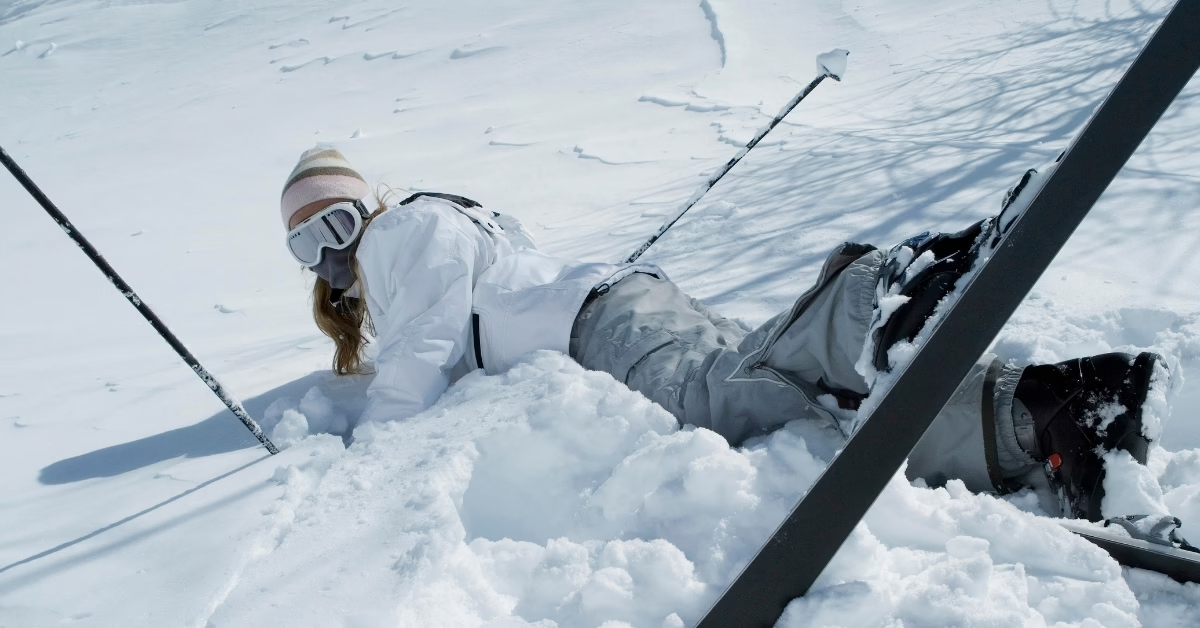Skiing can be an exhilarating experience, but falls are a part of the sport. Whether you’ve been skiing for years or are just a beginner, knowing how to recover from a skiing fall is essential. Falls can range from minor slips to more severe accidents, and understanding how to properly manage your recovery can make all the difference. In this guide, we’ll discuss everything you need to know, from immediate first aid to exercises that help restore your strength.
How to Recover from a Skiing Fall: Essential First Steps
After a skiing fall, the first few minutes are crucial. What you do right away can significantly impact how quickly you recover and whether you’ll face long-term consequences. Here’s what you should do immediately:
- Stay Calm and Assess the Situation
Don’t panic. Take a deep breath, and if possible, check yourself for any immediate injuries. Pay attention to any pain, swelling, or limited mobility. If you’re unsure about the extent of your injury, it’s always better to err on the side of caution and stay still until help arrives. - Evaluate Your Ability to Move
Carefully attempt to move your limbs. If there’s no significant pain and you feel stable, you may try to get up slowly. However, if there’s any sharp pain, especially in your neck or spine, do not move without medical assistance. - Seek Medical Attention
If you’re unable to get up or you feel severe pain, call for help immediately. Ski resorts often have trained medical staff who can assess your injury. It’s important not to ignore any symptoms of concussion, broken bones, or ligament injuries.
What to Do Right After a Skiing Fall to Minimize Injury
In addition to staying calm, there are specific actions you can take right after a skiing fall to minimize injury:
- Rest and Immobilize
If you’ve fallen and suspect a serious injury, resting and not moving are key. Avoid trying to continue skiing, as it can make the injury worse. - Use Ice to Reduce Swelling
Applying ice to the injured area helps reduce inflammation and numbs the pain. Do this within the first 48 hours of the injury to get the best results. - Hydrate and Nourish Your Body
Dehydration and poor nutrition can slow down the recovery process. Drink water and consume foods rich in protein and vitamins to support tissue healing.
Understanding the Most Common Skiing Injuries and Their Recovery Times
Skiing injuries vary in severity, but some are more common than others. Understanding the types of injuries and their typical recovery timelines can help set your expectations:
- Sprains and Strains
These are common injuries in skiing, often affecting the knees, wrists, and ankles. Recovery time typically ranges from a few days to a few weeks depending on the severity. - Fractures
Broken bones are also common and often result from high-impact falls. Fractures may require several weeks of rest and possibly physical therapy for full recovery. - Concussions
Head injuries are serious and require immediate attention. Rest is critical, and a doctor should assess the injury. Full recovery may take weeks, depending on the severity. - Dislocations
Dislocated joints, especially in the shoulder or knee, require immediate medical care. Recovery often involves rest, pain management, and physical therapy.
How to Assess the Severity of Your Skiing Injury After a Fall
It’s vital to assess the severity of your injury to determine whether you need medical attention:
- Sharp or Constant Pain
If you experience sharp or unrelenting pain, you likely have an injury that requires medical evaluation. - Swelling and Bruising
Swelling or bruising is common in soft tissue injuries. Significant swelling could indicate a more serious problem like a fracture or ligament tear. - Limited Movement
If you are unable to move your arm, leg, or other body parts without pain, it’s essential to see a doctor to rule out fractures or joint damage. - Headaches, Dizziness, or Nausea
Symptoms like headaches, dizziness, or nausea after a fall could indicate a concussion, requiring immediate attention.
The Importance of Rest in Skiing Injury Recovery
Rest is one of the most important components of recovery after a skiing fall. It allows your body to repair itself naturally. Here’s why:
- Healing Tissue
Injuries like strains and sprains heal faster with adequate rest, allowing tissues to repair and inflammation to subside. - Preventing Overuse Injuries
Returning to skiing too soon can aggravate your injury or cause new problems, especially if you push yourself before fully recovering. - Mental Recovery
Rest is not just about physical healing. Taking time off helps you regain the mental strength to get back on the slopes without fear or hesitation.
How to Use Ice and Heat Therapy for Skiing Injury Recovery
Ice and heat therapy are both effective methods for speeding up recovery. Here’s how to use them:
- Ice
Ice helps reduce swelling and numbs the pain in the first 48 hours after a fall. Apply ice wrapped in a cloth for 20 minutes every 2-3 hours. - Heat
After the initial 48 hours, you can switch to heat therapy. Heat helps increase blood flow to the area, promoting healing and alleviating stiffness.
Physical Therapy Exercises to Accelerate Recovery After a Skiing Fall
Once the acute phase of your injury has passed, physical therapy is crucial for regaining strength and mobility. Some recommended exercises include:
- Range-of-Motion Exercises
Gently stretch and move your injured joint to improve flexibility and prevent stiffness. - Strengthening Exercises
Focus on strengthening the muscles around the injured area to provide better support and prevent further injury. - Balance and Coordination
Skiing requires great balance. Practicing balance exercises can help you regain the confidence to return to skiing safely.
The Role of Nutrition in Skiing Injury Recovery
Proper nutrition plays a significant role in healing after an injury. Here’s what you should focus on:
- Protein
Protein helps repair muscles and tissues. Include lean meats, eggs, and plant-based proteins in your diet. - Vitamins C and D
Vitamin C helps with collagen formation, and Vitamin D aids in bone health. Ensure you get plenty of fruits, vegetables, and fortified dairy products. - Omega-3 Fatty Acids
These help reduce inflammation and support healing. Include fish like salmon or plant-based sources like chia seeds.
How to Manage Pain After a Skiing Fall Without Overdoing It
Managing pain after a skiing fall is important for a smooth recovery. Here are some tips:
- Over-the-Counter Pain Relievers
Non-steroidal anti-inflammatory drugs (NSAIDs) like ibuprofen can help control pain and inflammation. - Topical Treatments
Using creams or ointments can provide localized relief and speed up the healing process. - Mind-Body Practices
Techniques like meditation or yoga can help reduce pain and promote overall well-being.
How to Safely Return to Skiing After a Fall
Returning to skiing requires a gradual and safe approach. Here’s how:
- Start with Low-Impact Activities
Begin with exercises like walking, cycling, or swimming to build strength before returning to skiing. - Use Proper Equipment
Ensure your ski gear is properly fitted and in good condition. This will reduce the likelihood of future injuries. - Consult a Professional
If you’re unsure about your readiness to ski again, consult with a physical therapist or your doctor for advice.
The Psychological Impact of Skiing Falls and How to Overcome Fear
Falling can be traumatic, and overcoming the fear of skiing again is just as important as physical recovery. Here’s how to handle the psychological effects:
- Gradual Exposure
Start on easier slopes and work your way up gradually to rebuild confidence. - Positive Mindset
Focus on the joy of skiing rather than the fear of falling. It can help you regain your mental strength.
How to Prevent Future Skiing Falls and Injuries
Preventing future skiing falls is all about preparation and awareness:
- Proper Technique
Work on your skiing technique with an instructor to improve your control and reduce the risk of falling. - Safety Gear
Always wear appropriate safety equipment like helmets, knee pads, and wrist guards. - Know Your Limits
Don’t push yourself beyond your skill level, especially in unfamiliar conditions or terrain.
You May Also Like: How to Recover Permanently Deleted Photos: Step-by-Step Guide
Conclusion: Recovering from a Skiing Fall
Recovering from a skiing fall requires patience, proper care, and the right approach. By following the steps outlined in this guide, you can ensure that your recovery is smooth and effective. Whether it’s rest, physical therapy, or nutrition, taking the right actions at each stage will help you return to the slopes stronger and safer than before.
FAQs:
- How long does it take to recover from a skiing fall?
Recovery time varies, but minor injuries take a few days, while more severe ones, like fractures, may take weeks to months. - Should I see a doctor if I just have a minor skiing injury?
It’s always best to consult a doctor for any injury, even minor ones, to ensure proper healing and prevent complications. - Can I ski again after a concussion?
You should avoid skiing until fully cleared by a doctor to prevent further injury. Recovery can take weeks depending on the severity. - What are the best exercises for recovering from a skiing injury?
Range-of-motion, strengthening, and balance exercises help restore function. Consult a therapist for personalized recommendations. - How can I avoid skiing injuries in the future?
Practice proper technique, use the right equipment, and warm up before hitting the slopes to reduce the risk of injury. - How do I know if I need surgery after a skiing fall?
Surgery may be necessary for fractures, dislocations, or severe ligament tears. Consult a doctor for an assessment. - Is it safe to ski again after a sprained ankle?
After rest and rehabilitation, skiing is possible, but ensure you have full mobility and strength before returning. - What should I do if I feel afraid to ski after a fall?
Start on easier slopes, work on building confidence gradually, and consider mental techniques like relaxation to overcome fear. - What is the most common skiing injury and how long does it take to heal?
Knee injuries like ACL tears are common. Recovery may take 6-9 months with surgery and physical therapy. - How can nutrition speed up recovery from a skiing fall?
Foods rich in protein, vitamins C and D, and omega-3 fatty acids can help tissue repair and reduce inflammation.

Evelyn White is an experienced content writer with a background in lifestyle, trends, and practical advice. With several years of writing across digital platforms, she specializes in making everyday topics accessible, informative, and engaging. Her goal is to deliver trustworthy, reader-focused content that’s both useful and easy to understand.
Discover more from Try Hard Guides
Subscribe to get the latest posts sent to your email.

